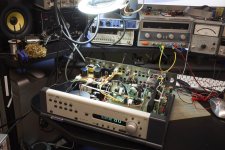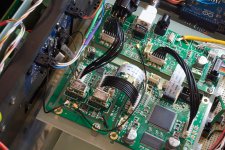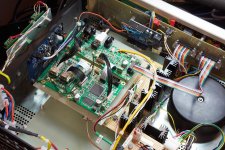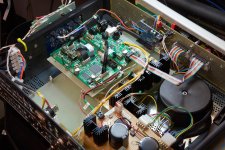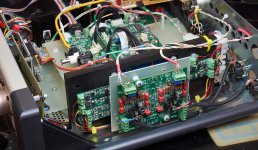hehe no worries, theres protection there, best use it.
Is there any simple circuit to avoid over-discharger the battery and won't create noise to the power?
Hi guys,
just to say that my Fifo implementation is done, and I have to say it sounds insanely good. I am amazed after two days of listening. DAC is ACKO DAC, with ESS 9012, with Legato I/V converter, followed by Lundahl transformers and all balanced jFet buffers. Legato board and buffers are fed with Shunty power supply, one for each channel. Analog active crossover is done as well with jFet buffers, feeding two J2 power amps and two X600 Pass amps.
DAC is controlled by Glt's Hifidunio and works flawlessly! Acko DAC is run in synchronous mode, and so far I had not a one glitch. This case, that was Proceed preamp, houses all digital circuits, while two other cases house Shunty and buffers. As you could see DAC is as close as physically possible to the FIFO and Clock board, so that W.FL and U.FL wires are only 60 mm long. Fifo seats above Lightharmonics USB to I2S board that at the time of picture taking was not mounted yet. Thank you Ian for such a great design!
just to say that my Fifo implementation is done, and I have to say it sounds insanely good. I am amazed after two days of listening. DAC is ACKO DAC, with ESS 9012, with Legato I/V converter, followed by Lundahl transformers and all balanced jFet buffers. Legato board and buffers are fed with Shunty power supply, one for each channel. Analog active crossover is done as well with jFet buffers, feeding two J2 power amps and two X600 Pass amps.
DAC is controlled by Glt's Hifidunio and works flawlessly! Acko DAC is run in synchronous mode, and so far I had not a one glitch. This case, that was Proceed preamp, houses all digital circuits, while two other cases house Shunty and buffers. As you could see DAC is as close as physically possible to the FIFO and Clock board, so that W.FL and U.FL wires are only 60 mm long. Fifo seats above Lightharmonics USB to I2S board that at the time of picture taking was not mounted yet. Thank you Ian for such a great design!
Attachments
Hi guys,
just to say that my Fifo implementation is done, and I have to say it sounds insanely good. I am amazed after two days of listening. DAC is ACKO DAC, with ESS 9012, with Legato I/V converter, followed by Lundahl transformers and all balanced jFet buffers. Legato board and buffers are fed with Shunty power supply, one for each channel. Analog active crossover is done as well with jFet buffers, feeding two J2 power amps and two X600 Pass amps.
DAC is controlled by Glt's Hifidunio and works flawlessly! Acko DAC is run in synchronous mode, and so far I had not a one glitch. This case, that was Proceed preamp, houses all digital circuits, while two other cases house Shunty and buffers. As you could see DAC is as close as physically possible to the FIFO and Clock board, so that W.FL and U.FL wires are only 60 mm long. Fifo seats above Lightharmonics USB to I2S board that at the time of picture taking was not mounted yet. Thank you Ian for such a great design!
Very nice! I feel honored to be part of the ultimate configuration
its quite cool indeed, I do have to wonder about the effectiveness of your clock board vibrational damping though
I cant see properly, obviously you arent having any troubles anyway, but is your MCLK u.fl the same length as the w.fl cables?
There shouldn't be any damping as he hasn't cut the connections.
AR2 : are you soldering the u.fl cables by yourself?
haha, did you seriously just say that? check the single O-ring over one corner while it is, as you correctly point out; still connected..... I guess your sarcasm-o-meter is faulty 
ermm no he isnt, besides they are crimped or welded normally. the cables are stock in every way. have you been unable to find short ones or something?
ermm no he isnt, besides they are crimped or welded normally. the cables are stock in every way. have you been unable to find short ones or something?
Last edited:
Very nice! I feel honored to be part of the ultimate configuration
Without your code, I believe most of us won't have the audio controller for BIII or have to wait forever for the AC2.
Glt thank you,Very nice! I feel honored to be part of the ultimate configuration
But the real credit should go to you an Ian and to some others like yourself on the DIYAudio who did the ground breaking work and research and shared the great results and ideas with the community here. The results of your knowledge, passion and generosity provided unlimited amount of happiness to me an many members here. All that I am doing is implementing what you provided us with. You website is unlimited source of knowledge, and your ideas and code are such a gift to us that it is hard to find words to thank you enough. And I mean it, the most sincerely because not once when I visited your site or read your posts, or used my DAC I thought of how much work you've done and how persistent you are in your tests.
So, thank you and Ian for such a gifts, I am just happy follower, that enjoys to thinker with this stuff during late nights after work.
There shouldn't be any damping as he hasn't cut the connections.
AR2 : are you soldering the u.fl cables by yourself?
haha, did you seriously just say that? check the single O-ring over one corner while it is, as you correctly point out; still connected..... I guess your sarcasm-o-meter is faulty
ermm no he isnt, besides they are crimped or welded normally. the cables are stock in every way. have you been unable to find short ones or something?
dunno, maybe he is, but hes used stock materials if he has. the crimpers for this are extremely expensive. seems a bit pointless.
Hahaha, nothing passes inspection and eyes here.
You guys are correct. The clock board is not cut yet, and the rubber rings are not placed yet. I tested only one to check the size. As you could see, I use a lots of various connectors in order to be able to easily assemble and disassemble when needed. And as I mentioned I still have to place back under the Fifo board my Lightharmonics I2S board in order to complete the project. When I do that, than I will cut clock board out of its frame and add the rest of distancers I have omitted for now. I still have to cut opening for I2S wires coming out from LIghthrmonic board, located bellow, so that they have the shortest rout. In this round, I wanted to test Fifo, S/PDIF input and Acko DAC, since in my previous build I had Buffalo II and I2S board running. Since I do these changes, seems like often, I wanted to make sure that everything is easy to assemble and disassemble.
As for the U.FL and W.FL funny that you ask that, as earlier I was cutting those wires and trying to make connector on one side to better fit on Lightharmonics board, but I have to say that I would not recommend that to anyone as it is extremely hard to work with them. No I did not crimp those myself, I just purchased a various lengths available to be purchased, as I knew that I will be tinkering and changing things in the case. I believe the shortest wire that they sell is 50mm, but that is very short. Now that I am settled in the case, I will replace U.FL wire that goes from S/PDIF board to clock board, since that is the one that I received from Ian with kit, and that one can definitely be shorter.
I do not remember what was the length for MCKL wire that goes from Acko board, but I think it is pretty much the same length as W.FL wires, which is 60mm.
I was just having a bit of fun, I guess because of language barrier and the fact that I do sometimes have a prominent niggler mode, the joke was missed by bigpandahk.
your system is very similar to mine at the moment, but much neater....aside from my NTD1 IV stage. but shortly I will dispense with the fifo for now and run the LH board for 4 channel (perhaps even 6 channel, using one of ackos new es9016 dacs for subs), so your mounting arrangements are very interesting to me, I will send you a PM as its offtopic for here. how is delrin for static build-up?
I will also be using a custom controller eventually, the idea being to run the whole system of amps and dacs with a single MCU with beaglebone or raspberry pi. hopefully Ian will do a multichannel fifo at some point, for now it will reside in my headphone rig.
I mentioned the length of the u.fl/w.fl cables because running sync mode it is more important for them all to be the same length, even if it means some of the cables are longer than they need to be to get from A to B
how do you find shunty compared with salas? i've been meaning to try out the shunty regs, since I have all the parts needed in my bin, thanks to our sausage sizzling friend's preference for easily available parts.
your system is very similar to mine at the moment, but much neater....aside from my NTD1 IV stage. but shortly I will dispense with the fifo for now and run the LH board for 4 channel (perhaps even 6 channel, using one of ackos new es9016 dacs for subs), so your mounting arrangements are very interesting to me, I will send you a PM as its offtopic for here. how is delrin for static build-up?
I will also be using a custom controller eventually, the idea being to run the whole system of amps and dacs with a single MCU with beaglebone or raspberry pi. hopefully Ian will do a multichannel fifo at some point, for now it will reside in my headphone rig.
I mentioned the length of the u.fl/w.fl cables because running sync mode it is more important for them all to be the same length, even if it means some of the cables are longer than they need to be to get from A to B
how do you find shunty compared with salas? i've been meaning to try out the shunty regs, since I have all the parts needed in my bin, thanks to our sausage sizzling friend's preference for easily available parts.
I was just having a bit of fun, I guess because of language barrier and the fact that I do sometimes have a prominent niggler mode, the joke was missed by bigpandahk.
I didn't miss your joke but It's a little difficult for me to understand and response to it
Hi guys,
just to say that my Fifo implementation is done, and I have to say it sounds insanely good. I am amazed after two days of listening. DAC is ACKO DAC, with ESS 9012, with Legato I/V converter, followed by Lundahl transformers and all balanced jFet buffers. Legato board and buffers are fed with Shunty power supply, one for each channel. Analog active crossover is done as well with jFet buffers, feeding two J2 power amps and two X600 Pass amps.
DAC is controlled by Glt's Hifidunio and works flawlessly! Acko DAC is run in synchronous mode, and so far I had not a one glitch. This case, that was Proceed preamp, houses all digital circuits, while two other cases house Shunty and buffers. As you could see DAC is as close as physically possible to the FIFO and Clock board, so that W.FL and U.FL wires are only 60 mm long. Fifo seats above Lightharmonics USB to I2S board that at the time of picture taking was not mounted yet. Thank you Ian for such a great design!
Very nice AR2! Awesome system! How many stuffs did you integrated together?
45.xxxx and 49.xxx clock? I didn't see the Lundahl transformers, where they are? What are the three rectangle boards under the I/V? Shunt regs? I guess you are waiting for the fifo isolator board now
Ian
Very nice AR2! Awesome system! How many stuffs did you integrated together?
45.xxxx and 49.xxx clock? I didn't see the Lundahl transformers, where they are? What are the three rectangle boards under the I/V? Shunt regs? I guess you are waiting for the fifo isolator board now. BTW, if you don't use the spdif output function, then you don't need connect the MCLK and the I2S output to the spdif board, may reduce a little bit on EMI.
Ian
You are right, as usual, those other boards are acko's regs for the DAC supplies, very nice regs indeed
Very nice AR2! Awesome system! How many stuffs did you integrated together?
45.xxxx and 49.xxx clock? I didn't see the Lundahl transformers, where they are? What are the three rectangle boards under the I/V? Shunt regs? I guess you are waiting for the fifo isolator board now. BTW, if you don't use the spdif output function, then you don't need connect the MCLK and the I2S output to the spdif board, may reduce a little bit on EMI.
Ian
Ian,
thank you for suggestions. Yes, I got Crystek 957s 45.xxx and 49.xxx. I did not want to pollute your thread with unrelated discussion, but since you ask I will try to explain my system that has been ever evolving and changing... First check this out. Here you could see my speakers and amps, and some early version of my electronics that has much changed since:
http://www.diyaudio.com/forums/pass-labs/186848-babelfishing-mighty-ar2.html#post2534929
The whole system is housed in three cases. Here is the shoot of original buffer board that in the most recent implementation I modified to serve as a crossover. There are actually now two of those, one above each other, where on the first one I have Lundahls with buffers - two channels balanced, and on the one above I have buffers with filters that is crossover. Crossover is two way balanced, complete discrete with jfets. The original board was developed by Choky - Zen Mode, Cviller and myself based on Nelson's B1. But instead of single ended solution we did it balanced for 6 channel without any caps in the way of signal with implemented caps multipliers in every stage. We did it as a output for voltage out DACs, at the time AK4396, for 6 channels.
Than I decided to change my DACs and selected Acko's DAC to make 4 channel digital crossover. After much research I realized that for Mac there is really only one digital crossover implemented through Pure Music player. That one is working really well, but only if you are plying files off your drive or server. If I would like simply to pop CD or play internet radio, that becomes problem and so far very unreliable. Since I would like to simply play music, and not to constantly change something on my computer, I gave up on computer based Xover. During my tests I realized that I was mostly frustrated and hated when things did not work properly when I simply wanted to listen internet radio, that Pure Music has hard time doing. Music is for listening and enjoyment and I decided to move to active analog Xover for that reason and simplify my life.
I think to have properly done digital Xover DSP solution is needed, and I still did not see one that gives me all I want. I have a Mac mini that fits my system set up, without monitor, that I access through Remote Access software, and I do not want to use PC, for that.
Anyways, I did not like that I needed to distroy that beautiful buffer board and to do some hot wiring, but that was the simplest way of making Crosover, since all the discrete buffers are there. The final configuration after ESS9012 DAC is Legato I/O board in the digital case, than balanced signal to Xover case first through Lundahl to eliminate DC and to double voltage as a means of amplification, than through first set of buffers and than through filters with buffers. I am using digital, passive relayed controlled volume control, just to adjust volume for bass portion of the signal, and the whole volume is controlled by Hifidunio.
Next to answer your question on DAC reguators, please see included pictures of DAC, regulator and Legato housing, that works really well, and saves a lots of space and at the same time keeps very short distance for wiring ether between regs and DAC or for I2S wiring. The material is Derlin - plastic made for machining.
Bellow FIFO board there is exceptional Lightharmonics USB to I2S board shown here, but at the moment of taking last pictures, not mounted yet:
Hifiduino with VFD Display H i F i D U I N O
And lastly, in the third case I have Shunty mighty boards that are supplying power to Legato and to buffer and crossover boards. See picture of board and heatsink implementation. They are in separate case, and they are exceptional power supplies. As for the digital PS I used transformer with several secondary windings and also separate transformer for Arduino. After that I have all double regulations with LDO regs from Linear Systems and TI, all before last regulators, so I have mostly triple regulation for almost all voltages that are in that case. In that manner I provide separate 5V for Fifo, 5V and 7.5V for USB to I2S Lightharmonics board, 10V digital for DAC, + and - 10V analog for DAC board.
And yes, I will be adding your battery control board for clock, isolator board, and Si570 clock board since I would like to have 384K capability.
Huh, this was long write up, but than could you imagine how much pleasure and suffering I endured during this process, hahaha. Thank you Ian for really great product and for sharing it with us all!
Attachments
-
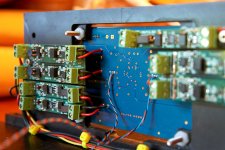 _DSC1860.jpg697.9 KB · Views: 364
_DSC1860.jpg697.9 KB · Views: 364 -
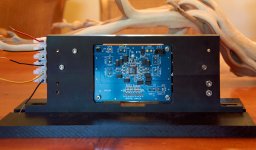 _DSC1856.jpg389.3 KB · Views: 353
_DSC1856.jpg389.3 KB · Views: 353 -
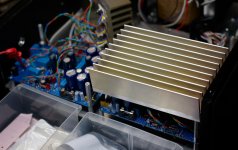 Shunty1.jpg397 KB · Views: 359
Shunty1.jpg397 KB · Views: 359 -
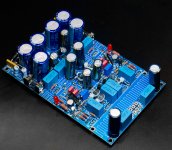 Shunty.jpg402.2 KB · Views: 608
Shunty.jpg402.2 KB · Views: 608 -
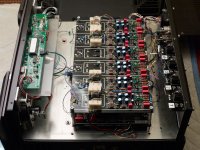 Untitled-12143.jpg832.5 KB · Views: 635
Untitled-12143.jpg832.5 KB · Views: 635 -
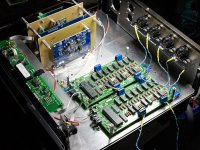 Case-and-Volume-control.jpg829.5 KB · Views: 648
Case-and-Volume-control.jpg829.5 KB · Views: 648 -
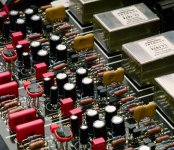 C65T5614.jpg198.8 KB · Views: 647
C65T5614.jpg198.8 KB · Views: 647 -
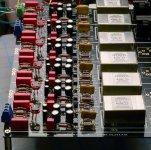 BufferBoardAssembled.jpg198 KB · Views: 672
BufferBoardAssembled.jpg198 KB · Views: 672 -
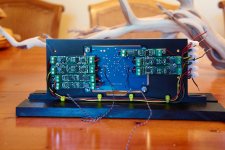 _DSC1855.jpg640.5 KB · Views: 341
_DSC1855.jpg640.5 KB · Views: 341
AR2,
I have no words ....

Neither my wife, hahaha. Last several years I have been saying just one more project to complete and I will be done...
Thank you.
hmm yes less complicated than digital hehe =)
ive seen your system before, but it still amazes me, you forgot poweramp and speaker pics, which are also quite incredible
btw Jack is working for Mac now, that would allow tapping any audio signal and sending it through the crossover, but since you are happy with the sound and can relax..sort of (as much as our types can relax)... now, may as well just do that.
ive seen your system before, but it still amazes me, you forgot poweramp and speaker pics, which are also quite incredible
btw Jack is working for Mac now, that would allow tapping any audio signal and sending it through the crossover, but since you are happy with the sound and can relax..sort of (as much as our types can relax)... now, may as well just do that.
- Home
- Source & Line
- Digital Line Level
- Asynchronous I2S FIFO project, an ultimate weapon to fight the jitter
